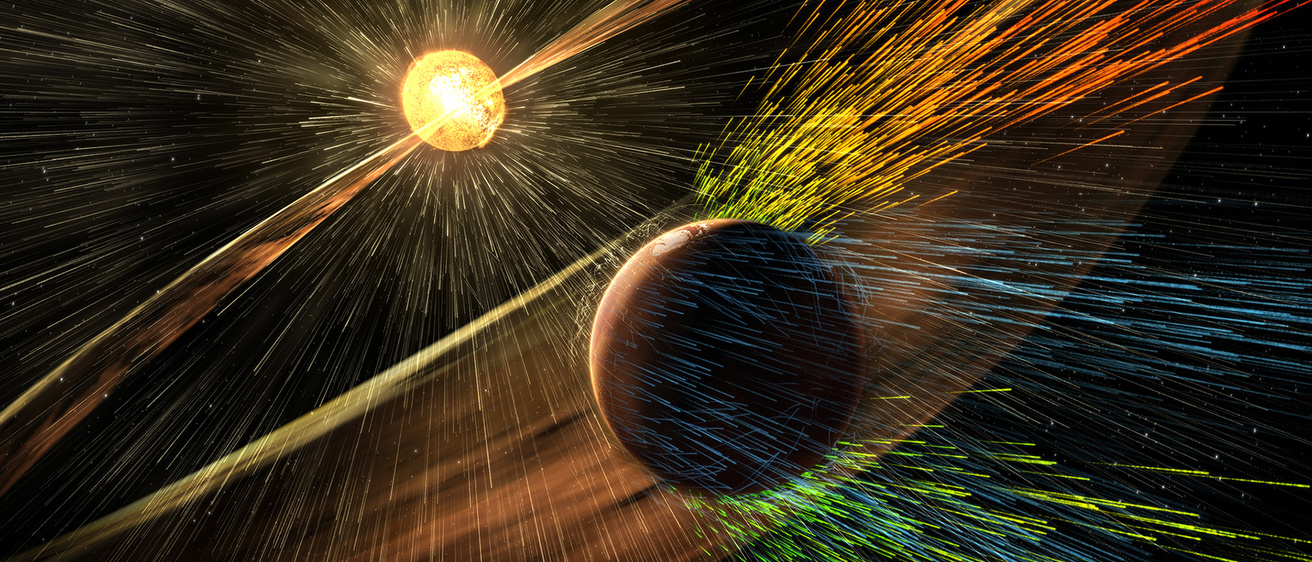The solar wind is a continuous, million-miles-per-hour blast of charged particles from the sun that affects all planets and every other body in the solar system.
The Earth would be far different—perhaps even unlivable—if it didn’t have a magnetic field forceful enough to repel most of the solar wind. The situation is nearly the reverse on Mars, with its weak magnetic field and thin atmosphere. On the red planet, the solar wind is ever-present.
Until one day, on Dec. 26, 2022, it wasn’t.

“When we first saw the data, and how dramatic the drop in the solar wind was, it was almost unbelievable,” says Jasper Halekas, professor in the Department of Physics and Astronomy at the University of Iowa and corresponding author on a new study describing the event. “We formed a working group to study the event, and we have found this time period to be ripe with incredible findings.”
The event was caused by a section of fast-moving solar wind that overtook a region of slower-moving solar wind, which acted like a broom, sweeping and compressing the two regions together. This interaction, called a co-rotating interaction region, left behind an unusual section of low-density solar wind.
The phenomenon was captured by the Solar Wind Ion Analyzer (SWIA) instrument on MAVEN, which was designed and built at Iowa.
“It’s very gratifying that MAVEN and SWIA are still making great discoveries today, more than 10 years after MAVEN’s launch and after more than 20,000 orbits around Mars,” Halekas says.
With the pressure of the solar wind gone, the magnetosphere and ionosphere of the red planet expanded by thousands of kilometers, and the physical characteristics of these regions changed dramatically. The interplanetary magnetic field that usually is entangled in the ionosphere was pushed outward, changing the ionosphere from a magnetized to unmagnetized state. At the same time, the magnetosheath, the layer that forms the interface between the solar wind and the magnetosphere, became unusually electromagnetically quiet.
“We are really getting to see how Mars responds when one of the main drivers of the system is removed,” Halekas added. “It makes for a great outlier study on what Mars would be like if it were near a less ‘windy’ star.”
Disappearing solar wind events on this scale are rare, and most often occur at a time of increasing solar activity, so this was the first time the MAVEN mission had the opportunity to observe such a phenomenon. While other spacecraft also observed the solar wind’s disappearance, only MAVEN was able to simultaneously gather data from the sun and the Martian atmosphere’s response to it.
The study, “The Day the Solar Wind Disappeared at Mars,” was published online Dec. 11 in the Journal of Geophysical Research: Space Physics and is being presented at the American Geophysical Union Fall Meeting in San Francisco. Halekas will be part of a special media briefing at the AGU meeting to describe the event.
The study’s co-authors are Skylar Shaver, Laila Andersson, Yaxue Dong, Xiaohua Fang, Hadi Madanian, and Neesha Regmi Schnepf, with the University of Colorado-Boulder; Abigail Azari, Shaosui Xu, Shannon Curry, Gwen Hanley, Takuya Hara, Robert Lillis, Christina Lee, Janet Luhmann, Melissa Marquette, James McFadden, David Mitchell, Ali Rahmati, University of California-Berkeley; Chris Fowler, with West Virginia University; Yingjuan Ma, with the University of California Los Angeles; Cesar Bertucci, with the University of Buenos Aires, Argentina; Chuanfei Dong, with Boston University; Philippe Garnier and Christian Mazelle, with the Universite de Toulouse, in France; Stephanie Kay Howard, with NASA Goddard Space Flight Center and Howard University; Andrea Hughes, with NASA Goddard Space Flight Center; Karim Meziane, with the University of New Brunswick; and Norberto Romanelli, with NASA Goddard Space Flight Center and the University of Maryland.
NASA funded the research.
